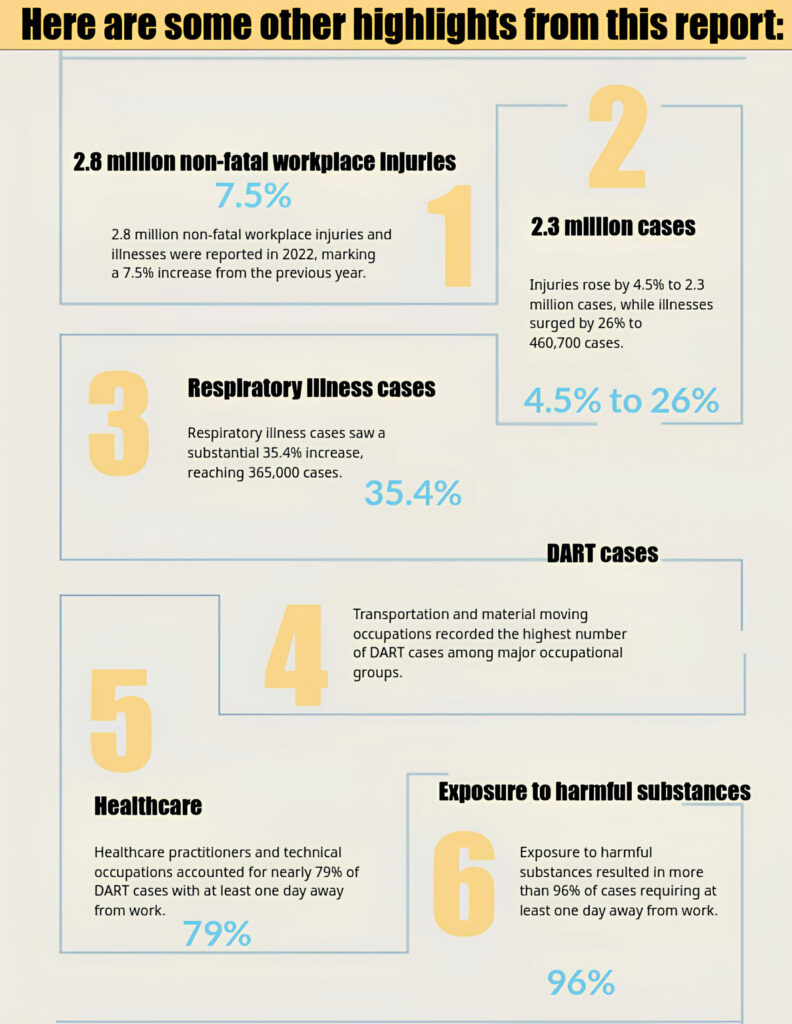How OSHA Improves Workplace Safety (Facts & Statistics)
Established in 1970, OSHA plays a pivotal role in safeguarding the well-being of employees by setting and enforcing standards for occupational health and safety. This regulatory agency was established through Occupational Health And Safety by Richard Nixon’s government.
Adhering to OSHA standards isn’t just a legal obligation; it’s a fundamental responsibility for businesses. Compliance ensures employees’ physical welfare, increases productivity, reduces absenteeism, and shields companies from costly legal battles.
In addition to its primary duties, OSHA regularly collects data related to workplace safety. Diving into these OSHA statistics allows us to explore the true state of worker well-being in different industries.
Let us explore the role of OSHA and discuss relevant workplace safety facts that highlights the role of this authority.
Overview of OSHA’s Role in Collecting Statistics
OSHA mandates electronic submission of work-related injury data through its Injury Tracking Application (ITA), emphasizing transparency and accountability for businesses. Employers must maintain records of serious injuries and illnesses, with exemptions for certain low-risk industries.
OSHA’s clear definitions of recordable incidents and first aid are used to assess workplace safety and guide protective measures. These records must be retained for five years, and annual summaries must be posted for employee awareness. Severe injuries, fatalities, amputations, or hospitalizations require prompt reporting to OSHA.
OSHA Injury Statistics and Illness Rates
According to the Bureau of Labor Statistics (BLS), private industry employers reported 2.8 million nonfatal workplace injuries and illnesses in 2022, up 7.5% from 2021.
Here are some other interesting workplace safety facts that paint a picture of the evolving landscape of occupational safety.
Wide Industry Variation:
Incidence rates for occupational injuries and illnesses vary significantly across industries, with construction at 3.5 cases per 100 workers and finance/insurance at 0.6 cases per 100 workers in 2020.
Increase in Cases:
Nonfatal injuries rose by 4.5% (2.3 million cases) in 2022, and nonfatal illnesses increased by 26.1% (460.7 thousand cases), driven largely by a 35.4% rise in respiratory illnesses. These safety facts in the workplace emphasize the growing need for stricter safety protocols.
Sector-Specific Rates:
Four of the five private sector incidence rates for 2022 remained unchanged, except for the DAFW rate, which increased from 1.1 to 1.2 cases per 100 full-time equivalent workers.
Stability in Injury Rate:
The private sector injury rate remained constant at 2.3 cases per 100 full-time equivalent workers in 2022, while the illness rate increased by 19.9% to 45.2 cases per 10,000 workers.
Work-related-injury and illness incidence rates, private industry, United States, 1973-2022
Common Reasons for Days Away from Work
When it comes to understanding what incidents result in days away from work, the OSHA statistics from 2022 shed light on some key trends in this aspect. A report from the year shows that overexertion and bodily reactions were the leading causes of days away from work, job restriction, or transfer (DART) across all occupations.

Fatal Occupational Injuries
According to the Bureau of Labor, there were 5,486 fatalities across sectors such as construction, manufacturing, mining, demolition, and many other sectors in 2022. Compared to this, there were 2,804,200 non-fatal injuries and illnesses in the same year. It is important to remember that this was a post-pandemic year when things were going back to normal.
Demographics Affected By Workplace Fatalities
Black and Latino populations are disproportionately affected by accidents in the workplace. Here’s how this plays out in different work environments:
Fatalities among Black or African American workers were most frequently attributed to transportation incidents, accounting for 278 cases, while injuries due to violence and other causes by persons or animals ranked second, resulting in 199 fatalities.
In the case of Hispanic or Latino workers, transportation incidents were also the primary cause of fatalities, with 439 cases, followed closely by falls, slips, or trips, which accounted for 286 fatalities.
Enforcement and Inspections
In order to decrease the number of fatal and non-fatal accidents, OSHA has conducted a number of inspections to ensure workplace safety and protect employees from potential hazards.
During Fiscal Year 2022, OSHA carried out a total of 31,820 inspections.
Among these inspections, approximately 56%, totaling 17,739, were unprogrammed inspections. Unprogrammed inspections encompass a variety of triggers, such as employee complaints, incidents involving injuries or fatalities, and referrals.
Within the 31,820 inspections conducted, approximately 44%, totaling 14,081, were programmed inspections. These programmed inspections were specifically targeted to concentrate OSHA’s enforcement efforts on industries and operations known to have existing hazards.
Number of inspections conducted annually:
OSHA’s ability to conduct inspections of different industries is often criticized. The authority conducted a total of 31,820 inspections in the year 2022, which many believe is not enough to assess the overall safety situation in different industries.
Types of violations commonly cited by OSHA:
Here are the most cited OSHA violations after the authority conducts inspections of different worksites. These citations alert employers to some of the hazards that can potentially injure their employees.
Impact of OSHA Regulations
In many instances, OSHA’s standards and inspections have played a crucial role in protecting workers from injuries and fatalities. There are multiple statistics, case studies, and practical examples of the authority ensuring better workplace environments.
Success Story #1:

Saint Paul Health Center
Saint Paul Health Center, situated near downtown Denver, boasts a 125-bed healthcare community and a 30-bed short-term rehabilitation facility. Prioritizing employee safety and well-being, the center collaborated with the Colorado State University Occupational Health and Safety Consultation program in 2006. Through this partnership, hazards were addressed, including deficiencies in OSHA-mandated programs, resulting in the Safety and Health Achievement Recognition Program (SHARP) status in 2008 and subsequent renewals.
Demonstrating a commitment to exemplary workplace safety, Saint Paul Health Center engages employees through initiatives like monthly safety talks, a recognition program, and a responsive safety management system, successfully navigating challenges posed by the COVID-19 pandemic. Companies interested in SHARP can explore no-cost, confidential services through their local OSHA On-Site Consultation program, emphasizing hazard identification, compliance advice, worker training, and safety program development.
Success Story #2:

Wisconsin On-Site Consultation
Saint Paul Health Center, situated near downtown Denver, boasts a 125-bed healthcare community and a 30-bed short-term rehabilitation facility. Prioritizing employee safety and well-being, the center collaborated with the Colorado State University Occupational Health and Safety Consultation program in 2006. Through this partnership, hazards were addressed, including deficiencies in OSHA-mandated programs, resulting in the Safety and Health Achievement Recognition Program (SHARP) status in 2008 and subsequent renewals.
Demonstrating a commitment to exemplary workplace safety, Saint Paul Health Center engages employees through initiatives like monthly safety talks, a recognition program, and a responsive safety management system, successfully navigating challenges posed by the COVID-19 pandemic. Companies interested in SHARP can explore no-cost, confidential services through their local OSHA On-Site Consultation program, emphasizing hazard identification, compliance advice, worker training, and safety program development.
Economic implications of workplace safety improvements
According to an estimation by the International Labor Organization, 4% of global GDP is lost due to work accidents and diseases. In the United States alone, workplace injuries result in substantial economic losses. For instance, this is how interruptions caused by worksite hazards impacted the US economy in 2021:
The total cost of injuries was $167.0 billion
Wage and productivity losses amount to $47.4 billion
Medical expenses were $36.6 billion
Administrative expenses due to accidents were $57.5 billion
Ongoing Challenges and Emerging Trends
While OSHA is putting forth its best efforts to protect workers in different industries, it is dealing with a number of exceptional challenges.
- The National Institute for Occupational Safety and Health (NIOSH) reports that over 22 million U.S. workers face exposure to harmful noise levels on the job, while an additional 9 million are subject to ototoxic chemicals, substances that can damage hearing and balance.
- According to the Bureau of Labor Statistics, around 10% of the American workforce, approximately 2.8 million workers, are classified as temporary workers.
- Weekly, the Bureau of Labor Statistics notes that approximately 100 individuals lose their lives in workplace incidents, potentially undercounting fatalities by not including COVID-19 transmission or gig worker-related deaths.
- As per the AFL-CIO’s “Death on the Job” report, an estimated 27 workers experience amputation or hospitalization daily, and in 2023, roughly 120,000 workers succumbed to occupational diseases.
Workplace hazards disproportionately impact low-wage workers, immigrants, and individuals of color, highlighting systemic disparities in occupational safety.
Emerging Risks And OSHA’s Response
Workplaces are constantly changing due to the emergence of new technologies, substances, and processes. Employees working with biotechnology, nanotechnology, and AI face a new set of risks that OSHA must mitigate by updating its standards. As construction, manufacturing, and other industries apply new methods, new hazards will emerge for OSHA to deal with.
OSHA Compliance Assistance and Resources
OSHA uses plenty of resources to examine the effectiveness of its standards and inspections.
- Total Recordable Incident Rate (TRIR): A benchmark for safety program evaluation, tracks incidents and hours worked, emphasizing the importance of a strong safety culture and effective incident investigation processes to minimize the impact of workplace incidents.
- Days Away, Restricted, or Transferred (DART) Rate: Focusing on incidents causing days away, restricted work, or transfer, aids in auditing high-risk industries and guides the implementation of a well-maintained safety culture for workplace safety and productivity.
- Lost Time Incident Frequency Rate (LTIFR): Calculating lost time incidents per 100 employees or hours worked, provides a measure of how workforce injuries impact productivity, highlighting the importance of OSHA safety policies, an organized workplace, and continuous monitoring.
- Lost Time Incident Injury Rate (LTIIR): LTIIR, focusing on injuries causing a loss of productive work time, offers a benchmark for companies to set goals for reducing incidents, emphasizing the need for a robust safety culture, incident investigation processes, and preventive measures to create a safer workplace.
Conclusion
A thorough examination of key OSHA statistics reveals valuable insights into workplace safety, highlighting prevalent risks and industry-specific challenges. These findings highlight why OSHA is important in the context of workplace injury prevention.
Employers must prioritize robust safety programs, employees should remain vigilant in adhering to safety protocols, and policymakers play a pivotal role in crafting legislative frameworks that promote a secure work environment.
It’s important to remember workplace safety is a collective responsibility and each stakeholder plays an integral role in making sure workplaces remain accident-free.






